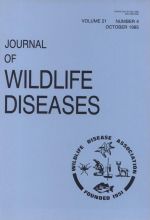Published reports of Brucella abortus infections in wild North American ungulates and domestic cattle herds were reviewed to determine if infection in these species was related. Bison (Bison bison) were frequently found infected, but are probably a minor threat to livestock due to their current limited distribution. Most elk (Cervus elaphus) were free of infection except where their range was shared with infected bison or livestock. Deer (Odocoileus spp.), pronghorns (Antilocapra americana), moose (Alces alces), and bighorn sheep (Ovis canadensis) appeared to be insignificant hosts of Brucella abortus. The lack of significant wild ungulate hosts and the distribution of infected livestock herds in the United States suggests that wild ungulates are of little importance in the epidemiology of infections by B. abortus in cattle.
How to translate text using browser tools
1 October 1985
THE ROLE OF WILD NORTH AMERICAN UNGULATES IN THE EPIDEMIOLOGY OF BOVINE BRUCELLOSIS: A REVIEW
Scott M. McCorquodale,
Ronald F. DiGiacomo





